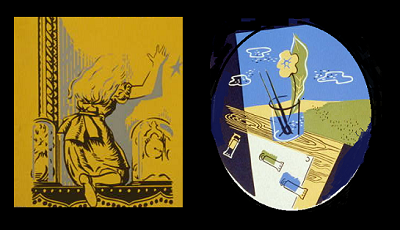Judy Malloy
A Party at Silver Beach
Combining words and images in a narrative of love and new beginnings, A Party at Silver Beach situates the reader at a party where visual images of the guests lead to their words. By clicking on graphic icons of guests, objects, or views from the windows, you move through the story like a guest at a party -- speaking to some guests, overhearing the conversations of others.
As if at a real party, you are invited to either stay for only a short time or to spend a longer time. As at any party, where many of the guests are strangers, you are likely to discover only a few of the mysteries of their lives. Lovers come and go, missing each other, finding each other. And sporadic dark conversations punctuate the generally joyous experience of the celebration of the wedding of a painter and a curator.
Throughout this work, each lexia is accessed by an icon, or to put it another way, the icons that surround the lexia space are linking devices that deliver the texts, and as if at a real party, the viewer wanders through the six scenes that comprise A Party at Silver Beach in the same way one would experience a real party, ie the cickable icons represent guests at the party, food, champagne, music, views to the ocean, and the house and gallery where the celebration takes place. Although it only plays on the virtual scale of a computer screen, Silver Beach was influenced by Renaissance masques that were presented at Italian courts for occasions such as the weddings of royalty, and the work also has somewhat the feel of a pastoral Purcell masque or semi-opera. It was also influenced by the Interactive Fiction tradition of discovering narrative by moving from room to room.
Notes
A Party at Silverbeach is
difference that a small amount of blue
part 2
The first edition of A Party at Silver Beach was written from 2002-2003.
When A Party in Silver Beach was finished, I liked it, but the icon-interfaced celebration was unexpected in early 21st century electronic literature. So, I put it aside. The first time this work was shown was ten years after its initial creation in my Retrospective at the 2012 Electronic Literature Organization Conference at West Virginia University, June 20-23, 2012.
The second edition was created in 2012 for this exhibition.
The observation could be made that the interface for this work uses Twitter icons that emit lexia texts into an icon-interfaced celebration. However, it should be noted that Twitter did not exist in 2002 when I began this work. At the time, I remembered the icons that I had used to produce text in the web version of "The Blue Notebook" (Uncle Roger File 2) and thought that I could use icons as a way to indicate who is speaking, which is sometimes difficult in diffuse works of electronic literature.
To tie together the already existing theme of lovers separating and reuniting, the device of Uncle Roger's magical music box was introduced in the 2012 version.
Simulating your arrival at a party, the first room you enter offers multiple entry ways to other rooms -- with more than one icon leading elsewhere.
In the other rooms, only the icon directly before the ? leads to another room. The ? always leads to the table of contents and guide to the work (which you are now reading).
The narrator is Jenny, the narrator of Uncle Roger.
1. The main room: The story begins in the main room of a house by the sea where the wedding celebration of Dorothy Abrona McCrae and Sid Seibelman is in progress.
2. The front deck: "in the sun, the afaerglow of the champagne, and the entrancing beat of the music"
3. A side deck: "In the distance, I painted scenes of unmarked battlegrounds, with no trace of what happened."
4. The beach: "two women sitting side by side..."
5. The gallery: "the gallery reflects our marriage"
6. The main room: "Will you dance with me?"
Credits:
The song title mentioned in room 2: "The Thirty Years War Waltz (for Jo Harvey)" -- is from the Album LUBBOCK (ON EVERYTHING) - TERRY ALLEN, Lyrics and music by Terry Allen
In rooms 3 and 5, the quote from Jane Austin's Pride and Prejudice: "They walked on without knowing in what direction...." can be found on p. 358 of the 1945 Doubleday edition.
On the beach, the excerpt from the song "Big Rock Candy Mountain": ".. by the lemonade springs where the bluebird sings at the big rock candy mountain" was written by Harry McClintock, in circa 1895. There is no particular time when A Party at Silver Beach takes place, so the song could be imagined as sung by John Hartford, who is still singing and playing the fiddle in my memories.
cover image: Carol Highsmith, courtesy of the Library of Congress
A party at Silverbeach is copyright 2002,2012,2017 Judy Malloy.
Last update, October 24, 2017.
